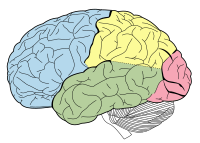
Photo from wikipedia
Frontal lobe epilepsy has a complex and atypical semiology that may masquerade as psychiatric or parasomnias [1]. An electroencephalography (EEG) and sleep lab workup should be an integral part of… Click to show full abstract
Frontal lobe epilepsy has a complex and atypical semiology that may masquerade as psychiatric or parasomnias [1]. An electroencephalography (EEG) and sleep lab workup should be an integral part of clinical assessment of these cases to avoid potential pitfalls in management with serious consequences as evidenced in this clinical vignette. By mistaking epilepsy for anxiety, imipramine, a tricyclic antidepressant, known to lower seizure threshold, was prescribed and resulted in status epilepticus. This letter concludes with a brief literature review of antidepressants and seizure risk. A six-year-old Lebanese girl was brought to the hospital by her recently divorced mother. The mother noticed her daughter lately experiencing sudden discrete episodes of awakening from sleep in the middle of night screaming, looking pallid, breaking a sweat, inconsolable, and, then totally amnestic to the event the next morning. Occasionally, she acted bizarrely. At times, this was associated with bedwetting. She was the only child, the product of a nonconsanguineous marriage and an uneventful elective caesarean section. She had normal developmental milestones with sphincters controlled at 3 years of age. The mother has been treated for neurotic depression on paroxetine. The girl had no medical history of note including absence of febrile seizures, head trauma and toxic exposures. She was not on medications; nor did she have a family history of epilepsy. She had normal thyroid function tests. On examination, she looked fretful, withdrawn, clinging to her mother, softspoken, with fleeting eye-contact, and startled. Her neurological exam was unremarkable. Given the current family vicissitudes, a diagnosis of adjustment disorder with prominent anxiety symptoms, comorbid with parasomnias-pavor nocturnus (night terrors) and secondary nocturnal enuresis was entertained. These ‘spells’ began to negatively impact her scholastic attendance because she kept feeling fatigued the next morning; therefore, she was prescribed imipramine 25 mg/d to help both anxiety and parasomnias. A baseline electrocardiogram was done (QTc of 330 ms). During a couple of weeks, the dose was titrated up to 75 mg/d. At this point, the girl ran serial seizures and was admitted to the intensive care unit (ICU) in a convulsive status epilepticus. EEG (transverse montage) was done and revealed frontal lobe epileptiform activity. MRI brain was done and came back normal. Retrospectively, these spells turned out to be epileptic activity and incontinence was mistaken for enuresis. Imipramine was discontinued by ICU team as it seems it had precipitated status because tricyclic antidepressants are notoriously pro-convulsants. The girl was discharged on carbamazepine, 100 mg bid, with good control of seizures. Three months have elapsed and, at the time of writing this report, she is faring well with no sleep-related incidents. Complete blood count, serum carbamazepine level and serum sodium are periodically checked and are within the normal lab reference range. Viva voce consent of the mother was obtained beforehand to publish this case anonymously. This case shows frontal lobe epilepsy (FLE) may produce unusual symptoms that can masquerade as a psychiatric disorder or a sleep disorder. It is commonly misconstrued and dismissed as histrionic gesticulations in casualty settings. FLE has a distinctive semiology, that is characterized by frequent seizures in stage 2 sleep, short duration, minimal postictal confusion, rapid secondary generalization, prominent motor manifestations, complex gestural automatisms (including sexual) at onset, frequent falling during seizure and frequent progression into status epilepticus [2]. Given the complex and atypical semiology of FLE, an EEG should be an integral part of the workup for any complex sleep phenomena before embarking on medications because misdiagnosis may lead to inaccurate decisions of prescriptions with serious implications as in this report (i.e. prescribing the tricyclic antidepressant imipramine known to lower seizure threshold). History, frontal lobe epilepsy and parasomnia scale (FLEPS), polysomnography, and, video-EEG can be diagnostic validators in these cases. Some helpful clinical tips in favour of frontal seizures vs. parasomnias are given in Table 1. * Ahmed Naguy [email protected]
Journal Title: World Journal of Pediatrics
Year Published: 2021
Link to full text (if available)
Share on Social Media: Sign Up to like & get
recommendations!